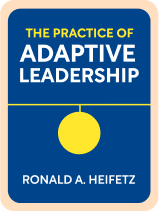

This article is an excerpt from the Shortform book guide to "The Practice of Adaptive Leadership" by Ronald A. Heifetz. Shortform has the world's best summaries and analyses of books you should be reading.
Like this article? Sign up for a free trial here .
What is an adaptive leadership style? What does “leading adaptively” entail in practice?
An adaptive leadership style is a leadership approach oriented towards tackling adaptive problems—challenges that are brought about by unexpected circumstances, that have no known solutions, and that require a fundamental change to solve. Leaders who adopt an adaptive leadership style constantly assess the landscape within which they operate and the adaptive capacity of their organization to make sure they have what it takes to adapt effectively.
In this article, we’ll take a look at the three main qualities of adaptive problems, the traits of adaptive leaders, and some tips for practicing an adaptive leadership style.
What Is Adaptive Leadership?
An “adaptive leadership style” is marshaling people to tackle problems with unknown solutions and thrive while doing so.
- (Shortform example: When a sales company expanded into a new region, adaptive leaders marshaled people to figure out what sales processes—or what completely new procedures—would work best in the new region’s market.)
These problems with unknown solutions are called “adaptive challenges.” The only way to solve them is for the people in organizations to learn and change. (Challenges with known solutions are called “technical problems” and can be solved using existing workflows and expertise.) Adaptive challenges have the following qualities:
- Loss. To move forward, old ways have to be left behind.
- Resistance. People resist change because they fear the loss that comes with it.
- Discomfort. Since the solution is unknown, addressing adaptive challenges involves experimentation, iteration, failure, disorientation, and conflict, all of which must often be uncomfortably endured for a long time.
Four Tips for Practicing Adaptive Leadership
Here are some tips to keep in mind throughout the process.
Tip #1: Get help from a partner or a team. This is for two reasons: It’s less lonely, and it’s easier for people to resist or stop a single person (you) than a group.
There are three reasons people try to lead alone even though it’s a bad idea:
- Their opponents isolate them. For example, an opponent might tell you how brave you are to be striking out alone, manipulating your positive feelings around courage to keep you isolated.
- Their friends let them be the guinea pig and only follow once it’s safe. (Shortform example: Your allies might hold off publicly supporting one of your interventions until they know that their bosses don’t oppose it.)
- Their passion gives them tunnel vision. For example, you might believe so strongly in your cause that you under-communicate, thinking the same things that are obvious to you are obvious to everyone.
Tip #2: Practice every time the opportunity arises. Anytime you get a chance to practice adaptive leadership, whether that’s in your personal or professional life, take it so that you’re regularly learning. Don’t let the opportunity pass because you’re “too busy,” or for any other excuse. Even if this only makes you spend 5% more time practicing, that’s enough to make a significant difference to your skill level.
Tip #3: Reflect before acting. It’s very common to want to take action to solve an adaptive challenge right away. Leaders are often under pressure and have been trained to address problems quickly, so they’re predisposed to cut diagnosis and observation short and move straight to intervention. However, this is a mistake: Adaptive challenges take time to even fully understand, never mind address effectively. Before acting, consider the risks, whether they’re worth it, and whether you’re the right person to lead.
If you hold a high position, you can hold back prematurely starting the intervention stage yourself. If you don’t hold a high position, you’ll have to use some of the following non-confrontational techniques (lest you be accused of negativity or blocking progress) to slow down the people above you:
- Veto action indirectly by withholding your support.
- Schedule extra time into meetings so that you have extra time to address adaptive challenges.
- Add to the list of people whose permission must be sought before an action is taken.
- See through cover-up arguments (such as scapegoating) and take time to determine the real cause of conflict (such as values).
- Ask questions instead of giving orders, and spend time discussing the answers.
Tip #4: Embrace adapting yourself. When you’re a leader, to get through a particular challenge, you’ll need to change yourself. This is difficult because, as noted, all changes involve loss, and, in a leader’s case, the loss can include abandoning deeply held values.
- (Shortform example: Angela requires her employees to wear formal attire but she’s losing people to other companies that are more casual. If Andrea agrees to change the dress code to retain people, she has to give up the value of formal attire, which for her goes much deeper than appearance—for her, formal attire stands for professionalism and dependability.)

———End of Preview———
Like what you just read? Read the rest of the world's best book summary and analysis of Ronald A. Heifetz's "The Practice of Adaptive Leadership" at Shortform .
Here's what you'll find in our full The Practice of Adaptive Leadership summary :
- How to deal with unknown solutions that require innovation, experimentation, and adaptation
- How to determine if a problem is technical or adaptive
- Five tips for launching initiatives to address adaptive challenges






